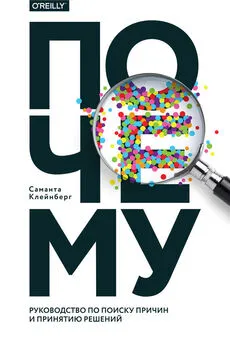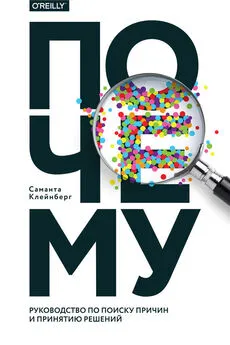Саманта Клейнберг - Почему
- Название:Почему
- Автор:
- Жанр:
- Издательство:Литагент МИФ без БК
- Год:2017
- Город:Москва
- ISBN:978-5-00100-593-3
- Рейтинг:
- Избранное:Добавить в избранное
-
Отзывы:
-
Ваша оценка:
Саманта Клейнберг - Почему краткое содержание
Книга будет интересна аналитикам, философам, исследователям, медикам, экономистам, юристам, начинающим ученым, всем, кто имеет дело с массивами данных и хочет научиться критическому мышлению.
На русском языке публикуется впервые.
Почему - читать онлайн бесплатно полную версию (весь текст целиком)
Интервал:
Закладка:
Buck, D. and Buehler, R. (2012). Bike Lanes and Other Determinants of Capital Bikeshare Trips. In 91st Transportation Research Board Annual Meeting .
Buehner, M. J. and May, J. (2003). Rethinking temporal contiguity and the judgement of causality: Effects of prior knowledge, experience, and reinforcement procedure. The Quarterly Journal of Experimental Psychology, Section A , 56(5): 865–890.
Buehner, M. J. and May, J. (2004). Abolishing the effect of reinforcement delay on human causal learning. The Quarterly Journal of Experimental Psychology, Section B , 57(2): 179–191.
Buehner, M. J. and McGregor, S. (2006). Temporal delays can facilitate causal attribution: Towards a general timeframe bias in causal induction. Thinking & Reasoning , 12(4): 353–378.
Campbell, M. K., Elbourne, D. R., and Altman, D. G. (2004). CONSORT statement: Extension to cluster randomised trials. BMJ , 328: 702–708.
Caporael, L. R. (1976). Ergotism: The Satan Loosed in Salem. Science , 192(4234): 21–26.
Carels, R. A., Konrad, K., and Harper, J. (2007). Individual differences in food perceptions and calorie estimation: An examination of dieting status, weight, and gender. Appetite , 49(2): 450–458.
Carey, B. (2012). Father’s Age Is Linked to Risk of Autism and Schizophrenia. The New York Times , August: p. A1.
Carey, B. (2013). Sleep Therapy Seen as an Aid for Depression. The New York Times , November: p. A1.
Carpenter, C. E. (1932). Workable Rules for Determining Proximate Cause. California Law Review , 20(3): 229–259.
Cartwright, N. (1999). Causal Diversity and the Markov Condition. Synthese , 121(1–2): 3–27.
Cartwright, N. (2001). What Is Wrong with Bayes Nets? The Monist , 84(2): 242–264.
Cartwright, N. (2002). Against Modularity, the Causal Markov Condition, and Any Link Between the Two: Comments on Hausman and Woodward. British Journal for the Philosophy of Science , 53(3): 411–453.
Cartwright, N. (2004). Causation: One Word, Many Things. Philosophy of Science , 71(5): 805–819.
Cartwright, N. (2012). Presidential Address: Will This Policy Work for You? Predicting Effectiveness Better: How Philosophy Helps. Philosophy of Science , 79(5): 973–989.
Chambers, C. D., Feredoes, E., Muthukumaraswamy, S. D., and Etchells, P. J. (2014). Instead of “playing the game” it is time to change the rules: Registered Reports at AIMS Neuroscience and beyond. AIMS Neuroscience , 1(1): 4–17.
Charney, E. and English, W. (2012). Candidate Genes and Political Behavior. American Political Science Review , 106(1): 1–34.
Charniak, E. (1991). Bayesian Networks without Tears. AI magazine , 12(4): 50–63.
Cheng, P. W. (1997). From covariation to causation: A causal power theory. Psychological review , 104(2): 367–405.
Cheng, P. W. and Novick, L. R. (1990). A probabilistic contrast model of causal induction. Journal of Personality and Social Psychology , 58(4): 545–567.
Cheng, P. W. and Novick, L. R. (1992). Covariation in natural causal induction. Psychological Review , 99(2): 365–382.
Cherry, W. H. and Oldford, R. W. (2003). Picturing Probability: The poverty of Venn diagrams, the richness of Eikosograms. Unpublished manuscript.
Choi, I., Dalal, R., Chu, K. P., and Park, H. (2003). Culture and Judgement of Causal Relevance. Journal of Personality and Social Psychology , 84(1): 46–59.
Choi, I., Nisbett, R. E., and Norenzayan, A. (1999). Causal Attribution Across Cultures: Variation and Universality. Psychological Bulletin , 125(1): 47–63.
Chrystal, K. A. and Mizen, P. (2003). Goodhart’s Law: Its origins, meaning and implications for monetary policy. In P. Mizen (ed.), Central Banking, Monetary Theory and Practice: Essays in Honour of Charles Goodhart , vol. 1, pp. 221–243. Edward Elgar Publishing, Northampton, MA.
Chua, H. F., Boland, J. E., and Nisbett, R. E. (2005). Cultural variation in eye movements during scene perception. Proceedings of the National Academy of Sciences , 102(35): 12629–12633.
Claxton, A. J., Cramer, J., and Pierce, C. (2001). A systematic review of the associations between dose regimens and medication compliance. Clinical Therapeutics , 23(8): 1296–1310.
Cohen, J. (2011). Chronic fatigue syndrome researcher fired amidst new controversy. Science . Retrieved from http://news.sciencemag.org/2011/10/chronic-fatigue-syndrome-researcher-fired-amidst-new-controversy .
Cohen, L. B., Rundell, L. J., Spellman, B. A., and Cashon, C. H. (1999). Infants’ perception of causal chains. Psychological Science , 10(5): 412–418.
Collins, H. and Pinch, T. (2008). Dr. Golem: How to Think about Medicine . University of Chicago Press, Chicago.
Conley, R. H. and Conley, J. M. (2009). Stories from the Jury Room: How Jurors Use Narrative to Process Evidence. Studies in Law, Politics, and Society , 49(2): 25–56.
Cook, N. R. and Ridker, P. M. (2014). Response to Comment on the Reports of Overestimation of ASCVD Risk Using the 2013 AHA/ACC Risk Equation. Circulation , 129(2): 268–269.
Cooke, P. (2009). Clarifications and corrections to ‘On the attribution of probabilities to the causes of disease’ by Peter Cooke and Arianna Cowling (Law, Probability and Risk (2005), 4, 251–256). Law, Probability & Risk , 8: 67–68.
Cooke, P. and Cowling, A. (2006). On the attribution of probabilities to the causes of disease. Law, Probability & Risk , 4(4): 251–256.
Cooper, G. F. (1999). An Overview of the Representation and Discovery of Causal Relationships Using Bayesian Networks. In C. Glymour and G. F. Cooper (eds.), Computation, Causation, and Discovery , pp. 3–62. AAAI Press and MIT Press, Cambridge, MA.
Cooper, G. F. and Herskovits, E. (1992). A Bayesian Method for the Induction of Probabilistic Networks from Data. Machine Learning , 9(4): 309–347.
Corrao, G., Rubbiati, L., Bagnardi, V., Zambon, A., and Poikolainen, K. (2000). Alcohol and coronary heart disease: A meta-analysis. Addiction , 95(10): 1505–1523.
Craig, P., Dieppe, P., Macintyre, S., Michie, S., Nazareth, I., and Petticrew, M. (2008). Developing and evaluating complex interventions: The new Medical Research Council guidance. BMJ , 337: a1655.
Crofton, J. (2006). The MRC randomized trial of streptomycin and its legacy: A view from the clinical front line. Journal of the Royal Society of Medicine , 99(10): 531–534.
Cushing, J. T. (1998). Philosophical Concepts in Physics . Cambridge University Press, Cambridge.
Cushman, F. (2008). Crime and punishment: Distinguishing the roles of causal and intentional analyses in moral judgment. Cognition , 108(2): 353–380.
Dalakas, M. C. (1995). Post-Polio Syndrome As an Evolved Clinical Entity. Annals of the New York Academy of Sciences , 753: 68–80.
Damisch, L., Stoberock, B., and Mussweiler, T. (2010). Keep Your Fingers Crossed! How Superstition Improves Performance. Psychological Science , 21(7): 1014–1020.
Danks, D. (2005). The Supposed Competition Between Theories of Human Causal Inference. Philosophical Psychology , 18(2): 259–272.
Dash, D., Voortman, M., and De Jongh, M. (2013). Sequences of mechanisms for causal reasoning in artificial intelligence. In Proceedings of the Twenty-Third International Joint Conference on Artificial Intelligence .
David, L., Seinfeld, J., and Goldman, M. (writers) and Cherones, T. (director). (1991). The stranded [Television series episode]. In David, L. (producer), Seinfeld . CBS, Los Angeles.
DeMaio, P. (2009). Bike-sharing: History, Impacts, Models of Provision, and Future. Journal of Public Transportation , 12(4): 41–56.
Devine, D. J., Clayton, L. D., Dunford, B. B., Seying, R., and Pryce, J. (2001). Jury decision making: 45 years of empirical research on deliberating groups. Psychology, Public Policy, and Law , 7(3): 622–727.
Diamond, S. S. and Rose, M. R. (2005). Real Juries. Annual Review of Law and Social Science , 1: 255–284.
Diamond, S. S., Vidmar, N., Rose, M., Ellis, L., and Murphy, B. (2003). Juror Discussions during Civil Trials: Studying an Arizona Innovation. Arizona Law Review , 45: 1–83.
Dickey, D. A. and Fuller, W. A. (1981). Likelihood Ratio Statistics for Autoregressive Time Series with a Unit Root. Econometrica , 49(4): 1057–1072.
Downs, J. S., Wisdom, J., Wansink, B., and Loewenstein, G. (2013). Supplementing Menu Labeling With Calorie Recommendations to Test for Facilitation Effects. American Journal of Public Health , 103(9): 1604–1609.
Drummond, C. (2009). Replicability is not Reproducibility: Nor is it Good Science. In Proceedings of the Evaluation Methods for Machine Learning Workshop at the 26th ICML .
DuHigg, C. (2012). Psst, You in Aisle 5. The New York Times Magazine , February: p. MM30.
Dumanovsky, T., Huang, C. Y., Nonas, C. A., Matte, T. D., Bassett, M. T., and Silver, L. D. (2011). Changes in energy content of lunchtime purchases from fast food restaurants after introduction of calorie labelling: Cross sectional customer surveys. BMJ , 343: d4464.
Dwyer, M. (2013). Coffee drinking tied to lower risk of suicide. Harvard Gazette . Retrieved from http://news.harvard.edu/gazette/story/2013/07/drinking-coffee-may-reduce-risk-of-suicide-by-50/ .
Eells, E. (1991). Probabilistic Causality . Cambridge University Press, Cambridge.
Efron, B. (2010). Large-Scale Inference: Empirical Bayes Methods for Estimation, Testing, and Prediction . Institute of Mathematical Statistics Monographs. Cambridge University Press, Cambridge.
Eichler, M. (2010). Graphical Gaussian Modelling of Multivariate Time Series with Latent Variables. In Proceedings of the 13th International Conference on Artificial Intelligence and Statistics .
Einstein, A., Podolsky, B., and Rosen, N. (1935). Can Quantum-Mechanical Description of Physical Reality Be Considered Complete? Physical Review , 47(10): 777–780.
Elbel, B., Kersh, R., Brescoll, V. L., and Dixon, L. B. (2009). Calorie Labeling And Food Choices: A First Look At The Effects On Low-Income People In New York City. Health Affairs , 28(6):w 1110–w1121.
Ellison, B., Lusk, J. L., and Davis, D. (2014). The Effect of Calorie Labels on Caloric Intake and Restaurant Revenue: Evidence from Two Full-Service Restaurants. Journal of Agricultural and Applied Economics , 46(2): 173–191.
Entner, D. and Hoyer, P. O. (2010). On Causal Discovery from Time Series Data using FCI. In Proceedings of the 5th European Workshop on Probabilistic Graphical Models .
Erickson, J. D. (1978). Down syndrome, paternal age, maternal age and birth order. Annals of Human Genetics , 41(3): 289–298.
Erlwein, O., Kaye, S., McClure, M. O., Weber, J., Wills, G., Collier, D., Wessely, S., and Cleare, A. (2010). Failure to Detect the Novel Retrovirus XMRV in Chronic Fatigue Syndrome. PloS ONE , 5(1): e8519.
Faro, D., McGill, A. L., and Hastie, R. (2013). The influence of perceived causa-tion on judgments of time: An integrative review and implications for decision-making. Frontiers in Psychology , 4: 217.
Fewtrell, M. S., Kennedy, K., Singhal, A., Martin, R. M., Ness, A., Hadders-Algra, M., Koletzko, B., and Lucas, A. (2008). How much loss to follow-up is acceptable in long-term randomised trials and prospective studies? Archives of Disease in Childhood , 93(6): 458–461.
Читать дальшеИнтервал:
Закладка:






![Саманта Даунинг - Моя дорогая жена [litres]](/books/1070823/samanta-dauning-moya-dorogaya-zhena-litres.webp)



